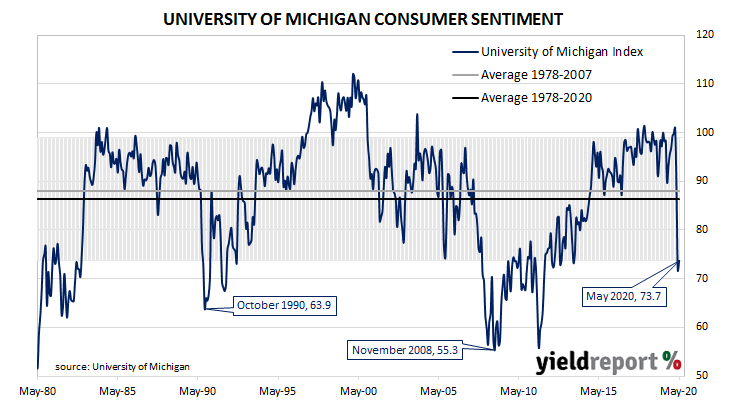Summary: US consumer confidence improves slightly; still under the lower bound of “normal”; inflation expectations rise despite depressed state of the economy.
US consumer confidence started 2019 at well-above-average levels in a longer-term context, although readings were markedly lower than those which had been typical of most of the previous year. During the rest of 2019, US households maintained historically-high levels of confidence except for two short-lived dips. 2020 started reasonably well but that changed in April.
The latest survey conducted by the University of Michigan indicates the average confidence level of US households improved a little while remaining at depressed levels. The University’s preliminary reading from its Index of Consumer Sentiment registered 73.7 in May, better than the expected figure of 67.5 and a slight rise from April’s final figure of 71.8.
The University’s Surveys of Consumers chief economist, Richard Curtin, said discounted prices and low interest rates had “partially offset” income uncertainty. However, he noted short-term expectations had continued to deteriorate even as households’ perceptions of current conditions improved. “Despite these gains, personal financial prospects for the year ahead continued to weaken, falling to the lowest level in almost six years, with declines especially sharp among upper income households.”
The report came out on the same day as a reports on retail sales, job openings (JOLTS) and industrial production numbers. US Treasury bond yields finished higher; the US 2-year Treasury yield remained unchanged at 0.15% while 10-year and 30-year yields both finished 4bps higher to 0.65% and 1.33% respectively.
In terms of US Fed policy, expectations of any change in the federal funds rate over the next 12 months remained fairly soft. However, OIS contracts from March 2021 onwards continued to imply a zero effective federal funds rate even after US Fed chief Jerome Powell recently repeated the Fed’s reluctance to embrace negative rates.

